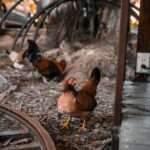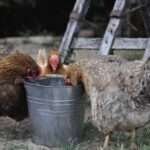If you’ve noticed a bare patch on your chicken, it’s natural to feel concerned and wonder what might be causing this sudden change in appearance. One common and natural occurrence that could explain this phenomenon is molting. In this article, we will reassure you with the best explanation for bare patches on your chicken, the symptoms to look for, when it typically occurs, and how to differentiate it from other causes of bare patches. We’ll also provide helpful tips on how to support your molting chickens and ensure their health and well-being.

1. Understanding Molting: What is it?
Molting is a natural process during which chickens shed their old feathers and grow new ones. It’s a rejuvenation period that allows the chickens to replace worn-out feathers, maintaining their plumage and overall health. Here are key points to understand about molting:
- Types of Molting: Chickens experience two primary types of molting: a partial molt and a complete molt. A partial molt typically occurs annually, during which chickens gradually replace specific feathers. A complete molt, which occurs less frequently, involves shedding and replacing almost all of the feathers on the chicken’s body.
- Feather Growth Cycle: The molting process starts with the cessation of egg-laying and the shedding of old feathers. As the old feathers fall out, new feathers begin to grow from the feather follicles. Feather growth is a gradual process that can take several weeks or even months to complete.
- Timing of Molting: Molting typically occurs during the late summer or early fall when the days become shorter and temperatures start to drop. However, individual chickens may exhibit variations in their molting patterns, influenced by factors such as breed, age, and environmental conditions.
2. Recognizing Molting: Symptoms and Timing of Bare Patches on Your Chicken
To determine if your chicken is molting, observe the following symptoms and timing:
- Feather Loss: During molting, chickens will experience feather loss, resulting in noticeable bare patches on their body. Feathers may appear loose, hanging, or completely shed. The extent of feather loss can vary depending on the molting type (partial or complete) and the individual chicken.
- Change in Egg Production: Molting chickens often reduce or cease egg-laying altogether. This is because their energy and resources are diverted toward feather growth rather than egg production. If you notice a significant decline in egg production during the molting period, it is likely a result of molting.
- Molting Duration: The molting process can take several weeks to months, depending on the chicken’s age, breed, and overall health. During this time, you may observe a mix of new feathers growing in alongside the old feathers that are shedding.
3. Supporting Molting Chickens: Do’s and Don’ts
If your chicken is molting, there are several things you can do to support them during this natural process:
- Provide a Balanced Diet: During molting, chickens require a nutritious diet to support feather regrowth. Offer a high-quality layer feed supplemented with additional protein-rich treats such as mealworms, scrambled eggs, or plain yogurt. Protein is essential for healthy feather development.
- Ensure Ample Hydration: Molting chickens require proper hydration, so ensure they have access to clean water at all times. Consider adding electrolytes to their water to provide extra support during the molting period. Adequate hydration aids in feather regrowth and overall well-being.
- Avoid Overhandling: Molting chickens may feel more vulnerable and sensitive due to their feather loss. Minimize unnecessary handling and avoid causing additional stress during this time. Give them space to focus on regrowing their feathers without unnecessary disturbances.
- Maintain Coop Cleanliness: A clean coop helps prevent feather-related infections and keeps your chickens comfortable during molting. Regularly clean the coop, replace bedding, and ensure good ventilation to promote a healthy environment. This is especially important as molting chickens may spend more time in the coop.
- Patience is Key: Molting is a natural process, and feather regrowth takes time to cover the bare patches on your chicken. Be patient and allow your chickens to complete the molting cycle at their own pace. Avoid the temptation to intervene unless there are signs of distress or other health issues.

4. Differentiating Molting from Other Causes of Bare Patches on Your Chicken
While molting is a common cause of bare patches, there are other potential reasons to consider. Here are some factors to help differentiate molting from other causes:
- Mites or Parasites: External parasites, such as mites or lice, can cause feather loss and irritation. Inspect your chicken’s skin and feathers for signs of parasites, including visible insects or tiny white eggs. You may also observe excessive scratching or agitation in chickens infested with parasites.
- Stress or Illness: Extreme stress, nutritional deficiencies, or certain illnesses can result in feather loss. Monitor your chicken’s overall health, behavior, and appetite for any signs of distress or underlying health issues. Other symptoms may include weight loss, lethargy, or changes in droppings.
- Feather Pecking or Cannibalism: Aggressive behavior among flock members can lead to feather pecking or cannibalism, resulting in bare patches. Assess the social dynamics within your flock and look for signs of aggression or bullying. If feather pecking is the cause, take steps to address the underlying issues, such as providing more space or distractions.
- Environmental Factors: Extreme weather conditions, such as excessive heat or cold, can cause feathers to shed or become damaged. Evaluate your chicken’s environment and make necessary adjustments to ensure their comfort and protection. Provide shade in hot weather and provide insulation or heat sources in cold weather.
- Disease or Infection: Certain diseases or infections can cause feather loss in chickens. If you suspect an underlying health issue, consult with a veterinarian who specializes in poultry to rule out any illnesses that require treatment or management.
To sum it up:
If you’ve noticed bare patches on your chicken, understanding the molting process can provide reassurance. Molting is a natural occurrence during which chickens shed old feathers and grow new ones. By recognizing the symptoms, supporting your molting chickens with a balanced diet and proper care, and differentiating molting from other causes of bare patches, you can ensure the health and well-being of your flock. Remember, molting is a temporary phase, and with time, your chickens will regrow their beautiful plumage, ready to face the seasons ahead. By providing the necessary support and patience, you can help your molting chickens through this natural process and maintain a healthy and vibrant flock.






